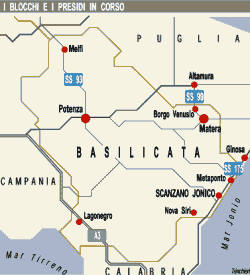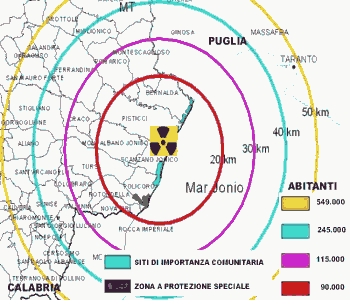|
Welcome
to Zona Nucleare (Nuclear Zone)
The
subject here is to provide analogies and facts on the argument regarding
the choice of a nuclear waste deposit in Italy and dealing in particular
with the Government decision of November 13th 2003 choosing the town of
Scanzano Ionico in Basilicata as the only possible site.
I will have a apolitic behaviour and I will mainly try to re-elaborate
news published in internet.
Please, if you find error or if you know news, tell me your more info.
in collaboration with

At the moment, I had not opportunity to
translate everything. So I wrote here under a little, but complete
introduction about "nuclear in Italy" and "only national site for
collection of nuclear wastes in Italy".
 November 1987
November 1987
After
the disaster of Chernobyl, a referendum (November 8th 1987) has banned
the use of nuclear power in Italy.
65.1% of Italians go to vote. The results were:
- 80.6% said No to the construction of nuclear power plants in Italy
- 71.9% said No to the share of the E.n.e.l. (Corporate body National
Electric Energy) to nuclear power plants to the foreign countries
- 79.7% said No to contributions to stimulate nuclear power plants
The radioactive waste are as of today kept in more places that one in
unsafe conditions. (generally near old nuclear power plants)
 March 2003
March 2003
The
Italian Government appoints General Carlo Jean, President of SOGIN,
as the Delegated Commissioner to implement safety rules to the nuclear
wastes produced in Italy, as well as the power to initiate dismantling
procedures of certain electronuclear plants of Garigliano (Caserta),
Trine Vercellese (Vercelli), Caorso (Piacenza) and Latina.
All the plants of the new technologies corporate entity as well as the
energy, environment and Nucleco. And also: Eurex nuclear waste
deposit and Fiat Avio nuclear waste deposit in Saluggia (Vercelli), plant Plutonium and plant Celle Calde
in Casaccia
(Roma), ITREC in Trisaia (Matera), FN nuclear plants in Bosco
Marengo (Alessandria)
At the same time commence the process to individualize a site fit for
deposits of nuclear waste with a group of consultants and experts
providing advice to SOGIN.
Soon rumors are spread that the possible sites could be located in
the regions of: Puglia, Sicily, Tuscany, Basilicata and Sardinia.
Sardinia being the most likely to be chosen.
 November 2003
November 2003
 On
November 13th 2003 without any previous notice by the Italian Government
(Consiglio Dei Ministri N. 131 – 13 Novembre 2003), chooses
Scanzano Ionico as the site to deposit 50,000 tons of nuclear waste,
which amounts to the total produced by the whole country. Scanzano
Ionico is of course located in the Basilicata region in southern Italy,
known for the archeologic richness and where many movies related to
ancient history have been filmed including the latest Mel Gibson’s (The
Passion of the Christ). In addition, Scanzano Ionico in particular, a
town of 50 years old is the biggest producer of agricultural products,
which include fruits and vegetables. On
November 13th 2003 without any previous notice by the Italian Government
(Consiglio Dei Ministri N. 131 – 13 Novembre 2003), chooses
Scanzano Ionico as the site to deposit 50,000 tons of nuclear waste,
which amounts to the total produced by the whole country. Scanzano
Ionico is of course located in the Basilicata region in southern Italy,
known for the archeologic richness and where many movies related to
ancient history have been filmed including the latest Mel Gibson’s (The
Passion of the Christ). In addition, Scanzano Ionico in particular, a
town of 50 years old is the biggest producer of agricultural products,
which include fruits and vegetables.
By coincidence, the company chosen for the construction of this site was
of course Sogin headed by General Carlo Jean (the
appointed Commissioner).
Some Government experts say that Scanzano Ionico has the morphology that «it is equivalent to the conditions of the select
national site in Usa for the same purpose». But the American site ("W.I.P.P."
- Waste Isolation Pilot Plant) is in the New Mexico desert. Away from
built-up areas and lands fit for cultivation.
Carlo Rubbia (scientist
of international fame and president of the C.N.R. – National Center
Searches in Italy) in an interview to the national televisions has
expressed doubts in a hasty and disputable choice.
The
plan is to bury the nuclear wastes in wells of 800 metres in depth in a
great bead of salt, based on studies and data from the early seventies
(they are words of the general Carlo Jean). Studies did not take into
consideration the seismic events that plagued Campania and Basilicata
(in 1980 and 1999) in the early eighties making the site unsafe for such
a project. Unlike the site chosen by USA in the desert New Mexico, where
on site studies were conducted for 25 years and not overnight like the
Italian Government.
As previously indicated, this would also destroy a very fertile area
along the Metaponto and including the “polis” of Pitagora, an area that
is today named the “California of Italy”.
 The
Basilicata does not meet any of the requirements other that the approval
of General Carlo Jean, therefore, the population organized pacific
protests for 20 days by blocking highways and railroads to stop all
traffic, and create awareness of the Italian population. The
Basilicata does not meet any of the requirements other that the approval
of General Carlo Jean, therefore, the population organized pacific
protests for 20 days by blocking highways and railroads to stop all
traffic, and create awareness of the Italian population.
The decision to choose Scanzano Ionico (Basilicata) as the national site
for nuclear wastes is strongly opposed and debatable based on the
following reasons:
1. The site is very close to the three dams that support the Basilicata
water system holding some 450 million cubic metres of water and
considered to be the biggest in Europe
2. The site is close to an area strongly subject to the phenomenon of
coast erosion
3. Basilicata is the Italian region with the greatest seismic activity
4. The Government itself has admitted that insufficient studies have
been conducted and like other countries, many years will be required to
conduct proper analysis
5. The Basilicata region is an area rich of values such as naturalistic,
historical and archeological. Scanzano Ionico is also protected by the
European Union for the Flora and Fauna. Nearby the city of Matera is
found, called the "city of the stones", which is now under the UNESCO
since 1994. Basilicata was also known as part of the “Magna Grecia”
during the Greek Empire
6. Agriculture is the main economy
It should be noted that the A.I.E.A. (Agency International Atomic
Energy) established rules for the deposit of nuclear waste, which are
not being followed especially regarding the choice of Scanzano Ionico.
One example of the irresponsibilities if the following: there is a
natural gas deposit with the site being less than 100 metres (109 yards)
from the sea. The costal line is subject to erosion at the rate of a
metre per year, which would lead to conclude that this site could be in
the sea 100 years from now.
 December 2003
December 2003
Following the protest of the Basilicata, which was supported almost
by all regions of Italy a new decree was issued November 14,
2003 # 314, which states the following:
the nomination of a new group of experts will be nominated in charge of
individualizing the of the safest site to become the centre of nuclear
waste deposits.
This
means that another analogous situation will be maximum one year.
 July 2004
July 2004
The
errand still has not been named.

 Recent News and
Observations
Recent News and
Observations

(only in english)
|
 The
only national site for collection of nuclear wastes in Italy,
The
only national site for collection of nuclear wastes in Italy,  The
only national site for collection of nuclear wastes in Italy,
The
only national site for collection of nuclear wastes in Italy,